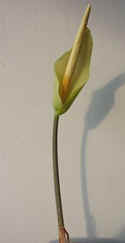

Silently and without warning, an Amorphophallus koratensis from Thailand bloomed in October after a long dormancy. This species is found throughout Indochina. It can be grown fairly easily using free draining soil rich in humus - like all Amorphophallus, stop watering when its dormant.

I was hesistant but Dr Hetterscheid assured me this is the white petiole form of the A. bufo, a native of dense forest of Peninsula Malaysia. This plant is not easy to cultivate as they seem to prefer constantly moist soil and yet can rot easily.

Both of my Amorphophallus variabilis bloom 1 week apart in July. This is a mid-size plant from Java, notice the long sterile portion of the spadix in this species. Unlike many members of this family, it has a plain green leaf and petiole. This robust plant is a common crop in parts of Indonesia.
Once again, I detect no smell - but suposedly it will only exude the famed odour in the late evening and only for 2-3 hours or so.


Amorphophallus asterostigmatus is a very handsome even without bloom, with fine deep green leflets and a silvery purple stem with spots. Seeds of this plant are reputed to be used for curry making. The known natural occurence of this plant is Lop Buri in Thailand

This is the bloom of Amorphophallus sumawongii from Thailand, a recently described species. This is a small plant and the bloom is only about 20cm tall. It likes shade and high humidity during growing season and is probably suitable for indoor culture.
Amorphophallus muelleri is a common species throughjout SE Asia, there are many forms but the bloom is more or less similar as shown.
This photo is from Dewey Fisk, click on the photo to goto his website.

